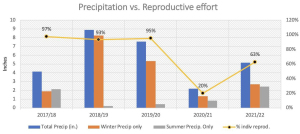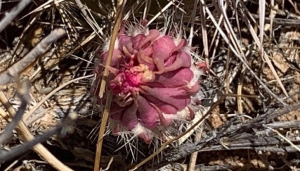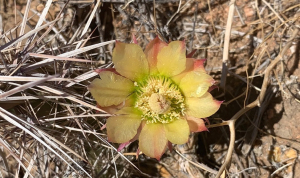Rare Plant Monitoring
EducationRare Plant Monitoring update, JULY 2022
Prepared by Tasha La Doux, JOTR Botanist, Rare Plant Program Lead
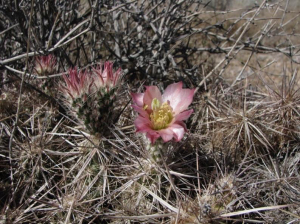
Currently, we are in the midst of reproductive monitoring for one of our rare cacti, Grusonia parishii (see photos). It is also known as Parish’s club-cholla because of the club-shaped stems (fatter at the top); it can also be distinguished by the long, white, flattened spines – a unique characteristic that sets it apart from other cacti. The global distribution of this mat-forming stem succulent is restricted to the southern tip of NV, AZ, and southeastern CA. The biggest threat right now is habitat loss by industrial scale solar development. The populations found in JOTR are important ecologically, as they represent an isolated southwesterly extension of the entire range. In other words, the plants found here could either be more susceptible to changes in climate or they could hold the most resilient plants to a hotter and drier future. Either way, the JOTR rare plant program is focused on gaining a better understanding of the reproductive biology and basic life history traits for this threatened species. The objective is to measure meaningful parameters for assessing long-term viability of the Grusonia parishii populations at JOTR. We are using a number of reproductive and vegetative measurements to assess change at three levels: individuals, subpopulations, and the overall population within the park. Questions that will be addressed:
- What influences reproductive effort? How often and under what climatic conditions does the plant attempt to flower?
- What is the success rate of flowering?
- Does herbivory account for a significant loss in reproductive success? What are the main herbivores causing this loss?
- Does the size of the individual effect flowering success? Can we determine a size-class relationship to reproductive success?
- How often and under what climatic conditions do we see mortality or recruitment?
- What is the average number of seeds produced by a fruit? And what is the average % viability for those seeds?
- What is the duration of reproductive effort for each reproductive stage: bud, flower, and fruit?
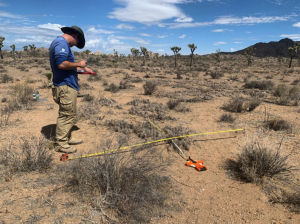
This season, thanks to the help of SCA interns and park volunteers, we have completed our annual vegetative monitoring (see photo) in which we collect plant cover data for live versus dead material. Parish’s club-cholla has also been called the Dead Cactus due to the dark gray appearance of the stems; however, during June and July the large (3-5 cm diameter) peach-colored flowers open midday making this cactus look very much alive. The flowers are quite spectacular, ranging in color from light yellow to apricot with dark red highlights. Due to the timing of flowering, we have to visit these plants in the heat of the day during the hottest part of the year. Luckily, we have some dedicated volunteers to help collect this data. During the summer months we plan to visit each of our 75 tagged individual plants and record the number of buds, flowers, and fruits on a weekly basis. We now have reproductive data for the last 5 years (see chart). The 2020/21 year was one of the driest on record for the region; it clearly had a lasting impact on reproductive effort. It appears that winter rainfall is more important than summer rainfall for reproduction, though further study is needed.
 One very exciting development from this year’s effort, from this last week in fact, is that we now have data to show that the flowers are only open for one day – a basic fact about this species that nobody had known until now. This kind of basic natural history information is lacking for many rare plants, as it requires some serious dedication and time. Fortunately, volunteer Christina Sanchez (see photo) was able to track and photograph several flowers over the last 2 weeks, leading first to the discovery that in fact the flowers do not stay open for 3-5 days as previously thought, but rather <3 days. After this, we had to adjust our sampling frequency in order to catch the same flower on the day it opened and closed. On July 6th, 2022, Christina was able to capture a flower on the morning it opened, then return the next day to discover it was already closed and senescing (see photo comparison). Now that we have shown this to be the case for at least three flowers, we need to gather more data in order to show that this is not an anomaly, but the norm. In the process, we are also learning about potential pollinators and herbivores. With the continued support from generous donors like Golden State Cider, we will finish this season and plan to repeat our sampling next year.
One very exciting development from this year’s effort, from this last week in fact, is that we now have data to show that the flowers are only open for one day – a basic fact about this species that nobody had known until now. This kind of basic natural history information is lacking for many rare plants, as it requires some serious dedication and time. Fortunately, volunteer Christina Sanchez (see photo) was able to track and photograph several flowers over the last 2 weeks, leading first to the discovery that in fact the flowers do not stay open for 3-5 days as previously thought, but rather <3 days. After this, we had to adjust our sampling frequency in order to catch the same flower on the day it opened and closed. On July 6th, 2022, Christina was able to capture a flower on the morning it opened, then return the next day to discover it was already closed and senescing (see photo comparison). Now that we have shown this to be the case for at least three flowers, we need to gather more data in order to show that this is not an anomaly, but the norm. In the process, we are also learning about potential pollinators and herbivores. With the continued support from generous donors like Golden State Cider, we will finish this season and plan to repeat our sampling next year.
